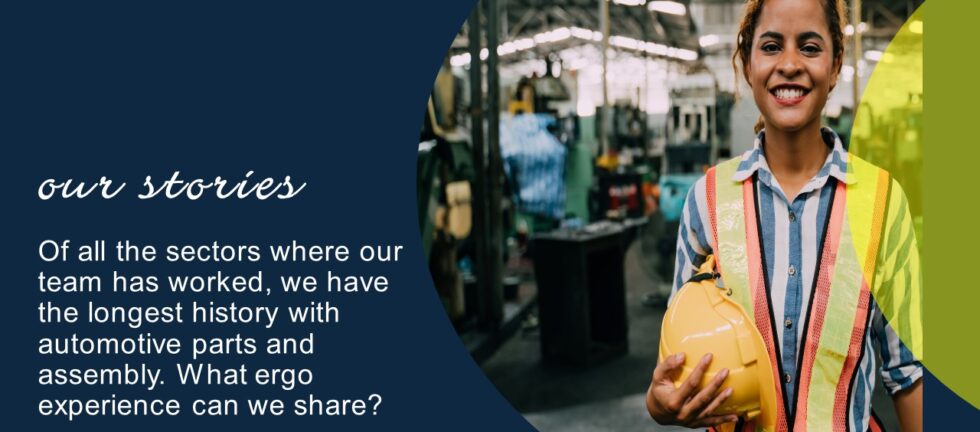This is the first in a series of articles about our experience in various employment sectors.
How is this sector unique?
The work in automotive parts is typically fast-paced, cyclic and repetitive. Some facilities use job rotation quite extensively, so one person might regularly do several jobs. This is great, because rotation can limit exposure to repetitive or sustained awkward movements. To understand what a “typical day” looks like, we might need to study all of these jobs.
Because the work is continuous, it’s relatively easy for us to gather the data that we need. In fact, in this environment, we often have the opportunity to see multiple workers performing the same job. More worker interaction ultimately leads to a deeper understanding of the job, and a better solution.
What approaches have worked best for you?
Carrie says, “I love to establish a regular presence in an automotive parts environment, so workers and salaried employees get to know me, and feel comfortable approaching me with their concerns and ideas.”
Ergonomics has been used in the automotive industry for decades, so lots of “off-the-shelf” solutions are available for this sector. Vendors are very willing to offer suggestions and even “loaner” tools, knowing that, if a solution works at one line, you might want to implement it in many other locations as well.
Many auto parts suppliers use continuous improvement or kaizen programs, so we’re able to collaborate to create in-house solutions when we can’t purchase something ready-made. Maintenance employees can be very creative, and love to use their tools and skills to come up with innovative, unique solutions. When we get hooked up with the right maintenance person, magic starts to happen!
What are the biggest ergo challenges in this sector?
Parts suppliers are continuously pressured by their customers to reduce costs, so they tend to be very cost-sensitive. We really need to look for opportunities to improve productivity and quality at the same time as reducing MSD risk. For example, our ergonomist might want to tilt a table to reduce neck bending, but we’ll be able to get financial support for the new table by showing that the worker can do a better inspection, thereby reducing rework costs.
What advice would you give to someone who is responsible for MSD prevention in this sector?
Because the work is repetitive, an ergonomist can perform lots of assessments in a relatively short time (compared to less repetitive jobs such as nursing or bus mechanic). Therefore, it’s important to prioritize efforts to ensure that we tackle the highest risk jobs first. Look for jobs with strain/sprain injuries, of course, but also talk to the supervisors.
- Do people have trouble keeping up to the work pace on certain jobs?
- Which jobs does the supervisor have trouble filling?
- Where do people make mistakes?
These are indicators of ergonomics issues that an ergonomist can help solve. The productivity, quality, and engagement indicators that help us find the problems will also be useful in helping to justify the improvement.
Other relevant points:
An ergonomist can help to identify accommodations for workers with injuries, and the same modifications that help an injured worker often benefit everyone. For example, a lift-and-tilt table that positions a bin to help a worker with back limitations can be used by everyone. Such a device might also save a second or two of time, or allow a worker to get a better grip and avoid dropping an odd-shaped part. In an environment with a 30-second cycle, saving a second or two can really add up!
Currently, competition amongst employers for workers is high, so having an ergonomics program could elevate your profile amongst prospective employees. Everyone wants to work for a company that takes care of its people!
Because we are based in southwestern Ontario, we have a very long history of working with automotive parts and assembly. Let us know how we can help!


